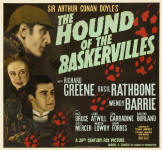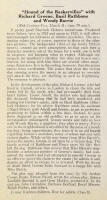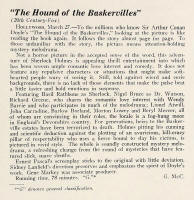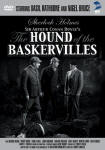The
Hound of the Baskervilles
|
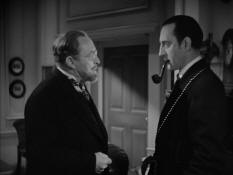 Dr. Mortimer and Holmes |
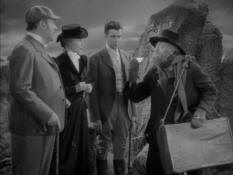 Watson, Miss Stapleton, Sir Henry, and Holmes (disguised as a peddler) |
Holmes appears as a peddler before Watson, Sir Henry and Miss Stapleton, and completely fools them. When Holmes has almost figured out the mystery, he removes his disguise, revealing himself to Watson. Watson is indignant when he realizes that Holmes has been there all the time, and didn't trust him enough to tell him! (Of course Watson has made a fool of himself by claiming to be the great detective Sherlock Holmes!) Holmes returns with Watson to Baskerville Hall to fill in some missing pieces to the puzzle. Even when Holmes has figured out who the murderer is, he cannot arrest him without evidence. Holmes says, "The only way is to catch him red-handed, to catch him in such a way that there's no escape, no alibi. And that means gambling with Sir Henry's life." Once again Holmes tells Sir Henry that he has nothing to fear, his troubles are over, and Holmes and Watson board a train headed for London. At the next stop, they disembark, take a train back and arrive at the moor just in the nick of time to save Sir Henry from being killed by the Hound. Holmes and Watson shoot the Hound dead. In the final scene, with nearly everyone present, Holmes explains how he figured out who the murderer and hound owner was. Feeling trapped, Stapleton pulls a gun on everyone, and then runs out of the house. Holmes does not give chase, explaining that the police are out in force on the roads, and the only other means of escape is across the deadly Grimpen Mire.
The Hound of the Baskervilles follows the original story by Sir Arthur Conan Doyle pretty closely. There are, however, some differences:
- The novel opens at 221B Baker Street with Holmes and Watson examining the walking stick left by Dr. Mortimer (Lionel Atwill), whom they haven't met yet. The film opens with the death of Sir Charles Baskerville and the neighbors discussing the circumstances of Sir Charles' death.
- In the novel, Mrs. Laura Lyons (Frankland's daughter) is a fairly important character, having arranged to meet Sir Charles on the night of his death. She is not mentioned in the film.
- In the novel Beryl Stapleton turns out to be married to Mr. Stapleton and only pretending to be his sister. There is no talk of an engagement to Sir Henry Baskerville. In the film Miss Stapleton (Wendy Barrie) really is the sister—step-sister, in fact, so there is a happy ending for Sir Henry (Richard Greene) and Beryl Stapleton.
- The seance scene with Mrs. Mortimer does not occur in the novel. In fact, Mrs. Mortimer does not appear as a character in the novel.
- Mrs. Hudson isn't mentioned in the novel.
- The trap that Holmes lays to catch the Hound is also different in the novel and film. In the novel Holmes, Watson and Lestrade are on the moor, waiting for Sir Henry to leave the Stapleton's house and walk home. They are ready and shoot the Hound before it has even scratched Sir Henry. In the film Holmes and Watson (minus Lestrade) are late getting to the moor because the carriage broke down and they don't reach Sir Henry and shoot the Hound before Sir Henry has been horribly mauled, almost to death. This is typical Hollywood: try to build up the suspense—"Will he get there in time to save Sir Henry?" It is out of character for Holmes to not have all the details worked out.
- In the film (and not in the novel) Holmes allows himself to get locked in the pit where the hound had been kept. How could Holmes be so stupid when he's supposed to be so brilliant?
- At the end of the film Holmes says, "Oh, Watson—the needle!" This line is not in the novel, but Holmes' use of morphine is documented in other stories. This line added nothing to the story—it's amazing that the censors allowed it.
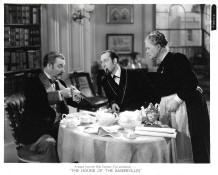 Mrs. Hudson tells Holmes he had a visitor. |
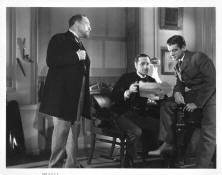 Dr. Mortimer tells Holmes and Sir Henry about the legend. |
In spite of some of the differences mentioned above, The Hound of the Baskervilles remains one of my favorite Sherlock Holmes films, and it of course established Basil Rathbone as the definitive Sherlock Holmes. I especially like the first scene with Holmes and Watson in Baker Street. The dialogue is almost word for word the same as in the novel, and the chemistry between Rathbone and Nigel Bruce is perfect. the later Universal films often feature Nigel Bruce's interpretation of Watson as a bumbling idiot, which is so different from the character appearing in Conan Doyle's stories. But in this film Bruce is much less bumbling, and actually appears to be a capable friend and physician.
Newspaper critic Rose Pelswick wrote, "Smoking the traditional pipe and playing the violin, but otherwise making the character credible rather than eccentric, Mr. Rathbone is vastly superior to the previous screen impersonators of the Baker Street genius." (quoted in Chris Steinbrunner and Norman Michaels, The Films of Sherlock Holmes)
Concerning the studio, Steinbrunner and Michaels noted that "Twentieth-Century Fox had an enormous, well-designed back lot with winding European streets ideally suited for London and the British villages detailed in the story." The liberal use of dry ice on the set created the eerie and ominous foggy atmosphere of the English moor and the ruins of a burial ground.
"The moor was an indoor set, built on a large soundstage spanning 300 by 200 feet and in such a way that different camera angles and slight redressing could trick the eye and create the impression of a vast expanse. Very helpful in this regard was a huge amount of fake fog pumped into the set; according to the studio publicity department, $93,000 of the production budget was spent on fog machines." —John M. Miller, Turner Classic Movies, http://www.tcm.com/this-month/article/247035%7C0/The-Hound-of-the-Baskervilles.html
Nigel Bruce wrote the following in his memoirs (posted on the Scarlet Street forums):
| "The Hound of the Baskervilles, which is perhaps
Conan Doyle's most exciting adventure of Sherlock Holmes, was
selected as the first vehicle for Basil and myself. Much of the
picture was made in a huge stage on the 20th-Century back lot. The
entire stage was surrounded by a circular screen of canvas on which
was painted a very lifelike picture of Dartmoor. The centre of the
stage was filled with large boulders made of plaster of paris. Here
and there a bridge was seen and several caves were visible. Running
through the boggy marsh-like ground were several small streams. For
eight weeks we worked in this set, and the atmosphere was most
unpleasant as the fog which was necessary to the story was made by
artificial methods and freshly pumped into the stage after every
shot. The effect reached, however, was eerie and foreboding and the
picture turned out to be an excellent one. Basil Rathbone looked exactly like every picture that one has ever seen of Sherlock Holmes; and the cast, which was a good one, included Wendy Barrie, Lionel Atwill, John Carradine and an attractive young newcomer from England by the name of Richard Greene. Our director was Sidney Lanfield. Lanfield had the reputation of being a tartar, but after a few outbursts during the first few days, Basil and I got on splendidly with him. Each morning we greeted him with great affection and both of us would plant a kiss on his furrowed brow. After each take we would shake hands and solemnly congratulate one another on our 'excellent performance.' We took the whole film in a mood of light-hearted enjoyment which left Sidney, who was accustomed to arguments and scenes, in a state of complete bafflement, and he gave up losing his temper in sheer self-defense. The result of this was that we all worked happily together and enjoyed every moment on the picture. I never worked with a nicer man than Basil, and I never acted with a more unselfish or more cooperative actor. The Baskervilles took from December 29th, 1938, to the 8th of March, 1939, and in the picture I earned nearly $10,000. The Hound of the Baskervilles was released....and its reception both in America and in England, where we felt they would be more critical, was beyond our wildest hopes. Basil was hailed as a splendid Sherlock Holmes and the critics not only gave him high praise but remarked that his resemblance to the general idea of the great detective was amazing. As Doctor Watson, I seemed to amuse and satisfy the many devoted admirers of the Conan Doyle characters. The London Sunday Pictorial said this of the film: 'In my excitement I dropped my hat, cigarettes, gloves and matches, and I let them stay on the floor until the lights went up.'" |
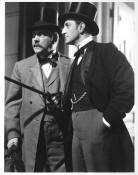 Holmes observes a cab following Sir Henry. |
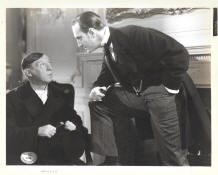 Holmes questions the cabby. |
This was the only film that Richard Greene and Basil Rathbone made together.
Wendy Barrie had previously acted with Basil Rathbone in 1935's A Feather in Her Hat.
Morton Lowry (Stapleton) had previously appeared with Rathbone in The Dawn Patrol, and later appeared in Pursuit to Algiers.
Lionel Atwill (Dr. Mortimer) would later play Moriarty in Sherlock Holmes and the Secret Weapon. He also appeared with Rathbone in Son of Frankenstein and The Sun Never Sets.
John Carradine (Barryman) acted with Basil Rathbone many years later in The Last Hurrah (1958), Hillbillys in a Haunted House (1967), and Autopsy of a Ghost (1967).
The Hound was played by a 140-pound Great Dane named Chief. He appeared suitably ferocious to frighten audiences even though no "glow-in-the-dark" phosphorus was used on him (as was on the hound in the novel).
"Had I made but the one Holmes picture, my first, The Hound of the Baskervilles, I should probably not be as well known as I am today. But within myself, as an artist, I should have been well content. Of all the 'adventures' The Hound is my favorite story, and it was in this picture that I had the stimulating experience of creating, within my own limited framework, a character that has intrigued me as much as any I have ever played." —Basil Rathbone, In and Out of Character
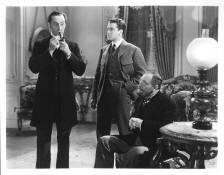 Holmes assures Sir Henry that he's not in danger. |
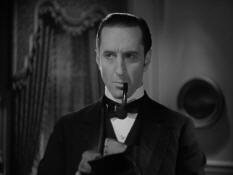 But Holmes knows that Sir Henry really is in danger. |
"One of the best screen versions of this oft-told tale. ... A big hit in a year of big hits, The Hound of the Baskervilles firmly established Basil Rathbone and Nigel Bruce as moviedom's definitive Sherlock Holmes and Dr. Watson." —Hal Erickson, Rovi
"Putting its straightest face upon the matter and being as weird as all get-out, the film succeeds rather well in reproducing Sir Arthur's macabre detective story along forthright cinema lines. The technicians have whipped up a moor at least twice as desolate as any ghost-story moor has need to be, the mist swirls steadily, the savage howl of the Baskerville hound is heard at all the melodramatically appropriate intervals and Mr. Holmes himself, with hunting cap, calabash and omniscience, whispers from time to time, 'It's murder, Watson, murder!'" —Frank Nugent, The New York Times, March 25, 1939
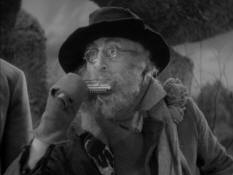 Holmes, disguised as a peddler. |
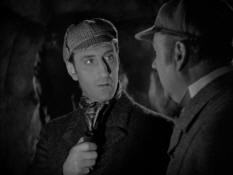 Holmes explains why he needed to be in disguise. |
"This mystery will have you holding on to your seats— It is indeed a pleasure to find Sherlock Holmes back on the screen this month. Especially when he is played by that grand actor Basil Rathbone, who is simply Mr. Holmes to a T." —Silver Screen, June 1939
"Basil Rathbone manages a Sherlock which should satisfy the exigent, and Nigel Bruce's Watson blunders through the mess of crime in fine spirits. The story may have been written thirty-seven years ago, but it still stands up." —John Mosher, The New Yorker, April 1, 1939
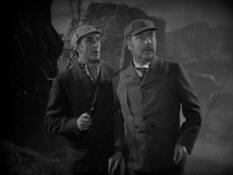 Holmes and Watson hear the howl of the hound. |
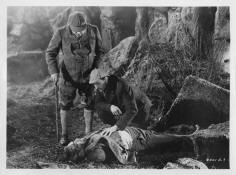 Holmes and Watson find the body of the convict. |
"The Hound of the Baskervilles makes few compromises in establishing itself as an unblushing 'chiller.' It hews straight to the line and spares no bone-rattling in striking out to the end. What few compromises it makes are expressly in the interests of artful performances and somewhat impressionistic scenic embellishments. It thus attaches to itself a Class A feeling throughout, while exerting a sustained appeal to 'horror picture' addicts." —The Reporter, March 27, 1939
See more photos and reviews of The Hound of the Baskervilles on page 2.
See Posters, Lobby Cards and Promo Photos on page 3.
.
|
|
The Hound of the Baskervilles is available on DVD
|
Images on this page and pages two and three are from the film The Hound of the Baskervilles, copyright 20th Century Fox.







